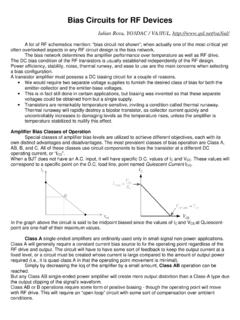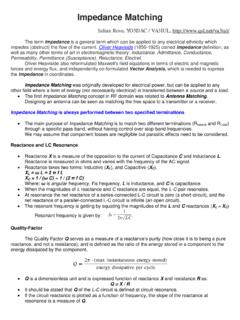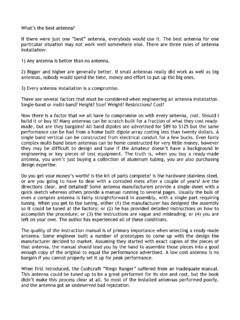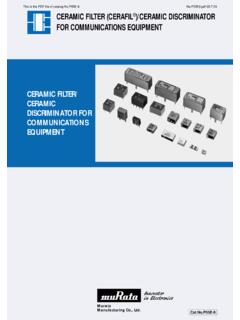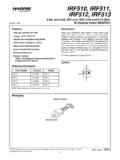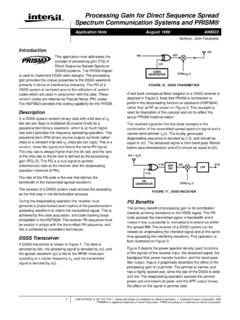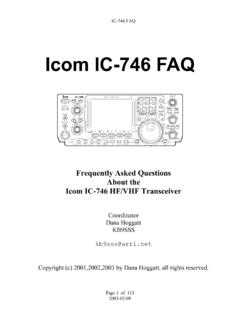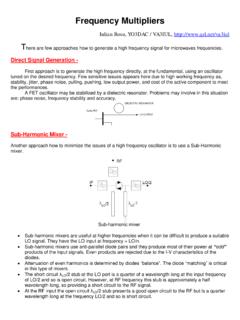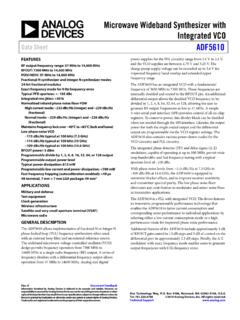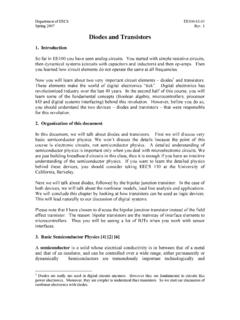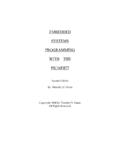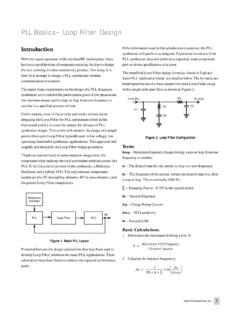Transcription of High Frequency VCO Design and Schematics
1 High Frequency VCO Design and Schematics Iulian Rosu, YO3 DAC / VA3 IUL, This note will review the process by which VCO (Voltage Controlled Oscillator). designers choose their oscillator's topology and devices based on performance requirements, components types and DC power requirements. Basic oscillator Design specifications often require a given output power into a specified load at the Design Frequency . The drive level and bias current set the fundamental output current and the oscillation Frequency is set by the resonator components. Transistor selection of the transistor should consider noise, Frequency , and power requirements.
2 Based on the particular device, the Design may account for parasitics of the device affecting resonator components as well as nonlinear performance specifications. All the VCO Schematics presented below were practical build using the Infineon SiGe transistor BFP420, and any of them can be re-tuned for different Frequency ranges changing varicaps and LC tank values. VCO Specifications The VCO must exhibit a low Phase Noise in order to meet the Sensitivity, Adjacent Channel and Blocking requirements. In digital modulation scheme the VCO's Phase Noise affects the Bit Error Rate requirements. High Pushing (change of the oscillation Frequency with supply voltage) can cause Phase Noise degradation due to increased sensitivity to the power supply noise.
3 Phase Noise varies typically by 3dB with temperature, in the 55 C to +85 C range. A buffer at the output is necessarily to isolate the VCO from any output load variations (Pulling) and to provide the required output power. Meeting simultaneously the output power and load pull specification directly with a stand-alone oscillator would be difficult. However, this buffer amplifier requires a higher supply current. Alternative would include to use at the output circulators, isolators or passive attenuators. VCO output power is usually measured into a 50-ohm load. Output power requirements specified in dBm, and tolerances vs tuning Frequency in dB.
4 The tuning slope is the slope of the Frequency to voltage tuning characteristic at any point and is the same as modulation sensitivity. The slope could be positive or negative. For a positive slope, the output Frequency . increases as the tuning voltage increases. Similarly, for a negative slope, the output Frequency decreases as the tuning voltage increases A monotonic tuning characteristic means that the Frequency is single valued at any tuning voltage and that the slope has the same sign across the tuning range. Tuning sensitivity as a function of tuning voltage is a measure of tuning linearity.
5 For any given application, have to specify the minimum and maximum of the tuning sensitivity. In the case of a VCO, the Frequency coverage is rather restricted since the influence of the feedback network is small compared to the active device itself. Conventional oscillator designs (with a LC circuit or transmission-line equivalent coupled to a negative-resistance active device will only provide a restricted Frequency coverage and poor stability). A negative resistance can easily be obtained from most microwave transistors when considering chip and package parasitics. Tuning flatness - As the VCO Frequency range is increased, the difficulty to achieve a flat output power is increased.
6 Adding an output filter to suppress harmonics may in some cases degrade power output flatness. The drive level should consider the trade-off between harmonic content, oscillator stability, and noise. VCO Design Recommendations Nonlinear Effects in VCOs Oscillator circuit nonlinearities cause low- Frequency noise components to be up-converted and to appear as noise sidebands on the VCO output. Although this statement is intuitively obvious, quantifying this mechanism is much more complex. Second-order nonlinear distortion determines the degree of noise contamination of the oscillator output for instance.
7 Therefore, second-order distortion in the oscillator should be minimized. The degree to which any oscillator accomplishes this goal can be judged based on the second harmonic output level of the oscillator. A good oscillator should exhibit 2nd harmonic levels on the order of -40dBc. Another useful indicator of good oscillator Design is the change in oscillation Frequency versus DC bias reduction. A slow reduction of the supply voltage from nominal to the point at which oscillation just ceases, should result in a very small Frequency change (for example, should be on the order of about of 20 kHz for a well-designed 2 GHz oscillator).
8 The oscillator excess open-loop gain (which is necessary for initial oscillator build-up). should be minimized in order to prevent amplitude fluctuations from being converted into significant Frequency fluctuations. The 2nd harmonic currents in the oscillator sustaining stage can appear in phase quadrature with the fundamental current, thereby worsening the conversion of AM. noise to PM noise. Ideally, the 2nd and 3rd harmonic frequencies should be placed well above the fT cut-off Frequency of the oscillator sustaining stage transistor, thereby minimizing this effect. In many VCOs, the spectral purity is dominated by AM to FM conversion mechanisms near the carrier Frequency .
9 One method to predict the AM-to-FM conversion effect in a varactor-tuned VCO is based on a simple observation of the VCO output Frequency oscillator signal amplitude. A change in the RF voltage amplitude across the tuning varactor normally affects the observed tuning capacitance value in the resonator, thereby providing one substantial AM-to-FM conversion mechanism in the oscillator. Other VCO impairments including injection locking, load pulling, and power supply Frequency pushing can cause serious oscillator performance degradation, particularly in phase- locked systems. If the induced impairments fall within the closed-loop bandwidth of the system, potentially chaotic spectral behavior can result.
10 Design margins must be identified and held for each of these potential problem areas. Injection Locking Injection locking can be shown that when a signal of sufficient amplitude and sufficiently small Frequency error is impressed on a free-running oscillator. Over time, the free-running oscillator changes its Frequency to that of the impressed signal with a corresponding change in its signal phase and amplitude. Normally, injection locking is a very undesirable situation, but it has been used to advantage on occasion such as in narrowband bit synchronizers. Load Pulling VCO load pulling refers to the change in oscillator Frequency that occurs when the oscillator load impedance is changed.
